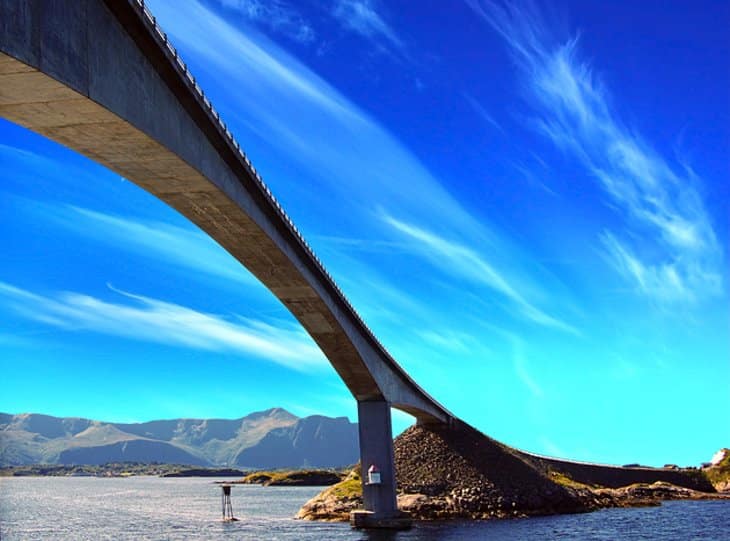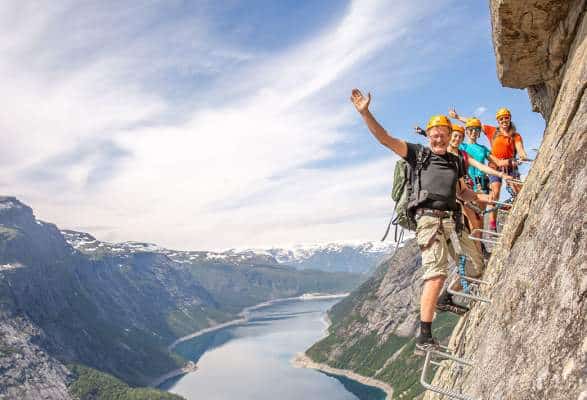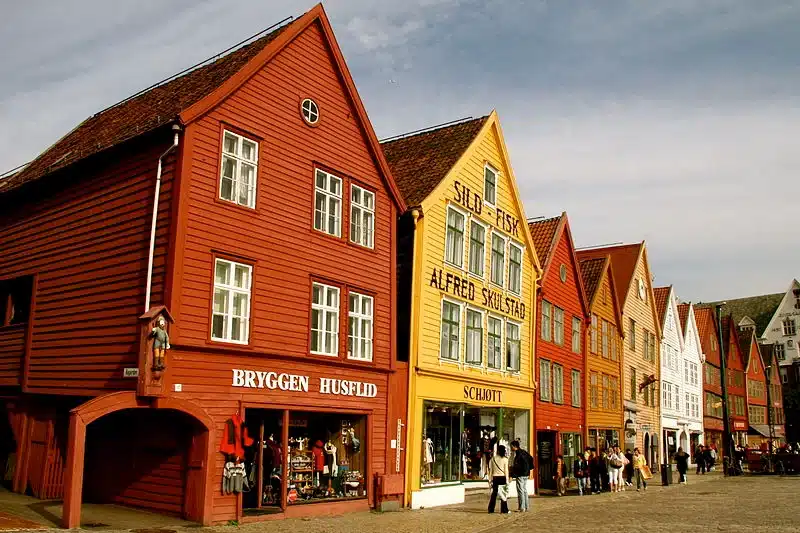Physical Address
304 North Cardinal St.
Dorchester Center, MA 02124
Physical Address
304 North Cardinal St.
Dorchester Center, MA 02124

Are you planning a trip to Norway and wondering what are the top tourist attractions that you cannot miss out on? Look no further, as we have compiled a comprehensive guide for you. From iconic rock formations to majestic fjords, Norway has something for everyone.
One of the most famous landmarks in Norway is the Trolltunga rock formation. This unique and stunning natural wonder is sure to take your breath away with its incredible views and challenging hiking trail. Another must-see attraction is the UNESCO World Heritage Site of Bryggen, which offers visitors a glimpse into Norway’s rich history and culture. So pack your bags and get ready to explore these amazing destinations!


You ready to feel the rush of adrenaline as you stand on the edge of Trolltunga, one of Norway’s most iconic and breathtaking rock formations? This natural wonder is located in the municipality of Odda and offers a challenging hike for adventurous travelers. The hiking trails are well-maintained, but the steep inclines and rocky terrain can be difficult for some.
The reward at the end is worth it though! Once you reach Trolltunga, prepare to be amazed by its sheer size and beauty. Jutting out 700 meters above sea level, this rock formation provides stunning views of Lake Ringedalsvatnet below. It’s no wonder that this spot has become so popular among tourists over the years.
But don’t just take our word for it – lace up your hiking boots and see it for yourself! After experiencing Trolltunga’s grandeur, make your way to Bergen where you’ll find another gem waiting to be explored: the UNESCO World Heritage Site of Bryggen.


As you wander through the picturesque streets of Bergen, you can’t help but notice the strikingly beautiful and historically significant Bryggen. This UNESCO World Heritage Site is home to a collection of colorful wooden buildings that date back to the 14th century, showcasing architectural beauty that will leave you in awe. As you explore this charming district, take note of its cultural significance as one of Norway’s most important trading ports throughout history.
Don’t miss out on exploring Norway’s rich historical significance, it’ll take you back in time and give you a glimpse into the country’s fascinating past. The country is filled with remarkable historical landmarks that are testament to its cultural heritage. Here are just a few reasons why exploring Norway’s history should be at the top of your to-do list:
With so much to see and experience, immersing yourself in Norway’s rich history is an activity that can’t be missed. As you continue your journey through Norway’s top 10 tourist attractions, prepare to marvel at some of the world’s most beautiful examples of architectural beauty.
Get ready to be mesmerized by Norway’s stunning examples of architectural beauty, from the towering spires of medieval cathedrals to the sleek lines of modern masterpieces. The country has a rich history of architectural design and continues to push boundaries with its modern designs and contemporary architecture. Here are some must-see attractions that showcase Norway’s architectural prowess:
| Attraction | Description |
|---|---|
| Oslo Opera House | This modern masterpiece is located in the heart of Oslo and features an angled white roof that slopes down into the harbor. Visitors can walk on top of the building for panoramic views or attend one of its world-class performances. |
| Juvet Landscape Hotel | Nestled in a valley surrounded by mountains, this hotel was designed to blend seamlessly with nature. Its minimalist design uses natural materials like wood and stone while providing guests with breathtaking views through floor-to-ceiling windows. |
| Sverre Fehn Pavilion | Located in Kongsberg, this pavilion was designed by renowned architect Sverre Fehn. Its unique shape and use of materials make it a standout attraction for visitors interested in contemporary architecture. |
| Holmenkollen Ski Jump Tower | Originally built in 1892, this ski jump tower has undergone several renovations over the years to become one of Norway’s most iconic structures. Its modern design features steel and glass elements that shimmer against the surrounding landscape. |
| Trollstigen Visitor Centre | This visitor center sits at the foot of Trollstigen mountain pass and boasts an impressive cantilevered viewing platform that juts out over the valley below. Its beautiful design incorporates local materials like granite and larch wood. |
These stunning examples are just a taste of what Norway has to offer when it comes to architectural beauty. Now let’s move on to explore some attractions that hold cultural significance for Norwegians and visitors alike…
Let’s delve into the cultural significance of some of Norway’s most beloved landmarks and discover what makes them so special to Norwegians and visitors alike. One of these landmarks is the Stave Churches, which are unique wooden structures that have been around since medieval times. These churches represent a mix of Christian and Viking cultural traditions, with intricate carvings and designs that tell stories from the Bible alongside pagan symbols.
Norway also has a rich tradition of festivals and celebrations throughout the year, many of which have deep cultural roots. One such festival is Syttende Mai (May 17th), which celebrates Norway’s independence from Sweden in 1814. This day is marked by parades, traditional costumes, music, and plenty of food and drink. Other notable festivals include St. Olav’s Festival in Trondheim, celebrating Norway’s patron saint with concerts, processions, and historical reenactments; and Bergen International Festival, an annual celebration of music, theatre, dance, and visual art held every May/June. With all these cultural traditions on display across Norway’s top attractions, it’s no wonder this country is such a draw for visitors seeking an immersive experience in Nordic culture.
As we move onto the subsequent section about ‘the majestic fjords’, we can’t help but note how much they too play into Norwegian culture – representing both its stunning natural beauty as well as its seafaring history.
The fjords in Norway are simply breathtaking, making them a must-see attraction for any traveler. These natural wonders are carved out of the rugged coastline and stretch inland, forming deep valleys with steep cliffs that rise high above the water. The best way to experience these majestic fjords is by taking a boat tour or hiking along one of the many trails that wind their way through the mountains.
Hiking trails provide an up-close experience with the stunning landscape of Norway’s fjords. You can trek through lush green forests, climb steep hillsides, and stand in awe of cascading waterfalls that plunge into the sea below. As you make your way along these paths, you’ll be rewarded with panoramic views of the surrounding mountains and valleys.
Boat tours offer a different perspective on Norway’s fjords as you sail past towering cliffs and sparkling waterfalls. The calm waters give you a chance to relax and soak in the beauty around you while listening to your guide share fascinating stories about the history and culture of this magnificent region. Whether by land or by sea, exploring Norway’s majestic fjords is an unforgettable experience that should not be missed.
The Majestic Fjords lead us into another amazing attraction in Norway – The Vigeland Sculpture Park where over 200 bronze, granite, and cast iron sculptures await visitors among beautifully landscaped gardens.
As you make your way through Norway’s capital city of Oslo, don’t miss out on the opportunity to visit the Vigeland Sculpture Park. This stunning park is home to over 200 bronze, granite, and cast iron sculptures created by Norwegian artist Gustav Vigeland. Not only will you appreciate the artistic significance of these sculptures, but you’ll also have a cultural experience as you learn about the history and traditions of Norway through this incredible display of art.
Norway’s artistic significance is truly remarkable, with stunning works of art scattered throughout the country. The Vigeland Sculpture Park is just one example of Norway’s dedication to artistic interpretation and creative expression. Gustav Vigeland’s sculptures are not only visually appealing, but they also convey deep meanings and emotions.
Each sculpture in the park tells a unique story and offers a glimpse into Norwegian culture. From the famous “Angry Boy”to the expansive “Monolith,”these pieces of art have become cultural landmarks in Oslo. Visiting the Vigeland Sculpture Park is not just a sightseeing experience, but it is also an opportunity to immerse yourself in Norway’s rich artistic and cultural heritage.
Now that you have explored Norway’s artistic significance, it’s time to dive into the country’s rich cultural experiences. One of the best ways to immerse yourself in Norwegian culture is through its traditional cuisine. From hearty stews and savory meatballs to freshly caught seafood and sweet pastries, there is no shortage of delicious dishes to try. Be sure to sample some of Norway’s famous cheeses like brunost (brown cheese) or gjetost (goat cheese). And don’t forget about the popular aquavit, a distilled spirit made with herbs and spices.
In addition to food, Norway also boasts a vibrant calendar of festivals and celebrations throughout the year. One of the most famous is the annual winter sports festival in Holmenkollen where visitors can witness ski jumping competitions, cross-country skiing races, and other winter sports events. For music lovers, there’s the Bergen International Festival which showcases classical music performances from around the world. And for those interested in Viking history, there’s the annual Viking Festival at Avaldsnes which features reenactments, storytelling sessions, and demonstrations of ancient crafts.
As you step into this world full of flavors and traditions, prepare yourself for another exciting part – stunning sculptures!
Get ready to be amazed by the incredible sculptures found throughout Norway, from Gustav Vigeland’s iconic statues in Oslo’s Frogner Park to the unique works of art created by local artists in cities and towns across the country. These sculptures are not just mere structures but a form of artistic representation, with each piece telling a story and conveying an emotion. Here are four stunning public art installations that you shouldn’t miss during your visit to Norway:
As you finish exploring Norway’s stunning sculptures scene and get ready for more adventures on your trip, make sure not to miss out on visiting one of its most iconic landmarks: the Oslo Opera House.
You’re in for a treat with the next attraction on our list: The Oslo Opera House. This architectural masterpiece is not only visually stunning but also holds significant cultural importance in Norway. As you make your way up to the rooftop, be prepared for breathtaking views of the surrounding area and fjord.
Don’t miss out on experiencing the breathtaking architectural designs that Norway has to offer, from the modern and sleek Oslo Opera House to the stunning medieval Nidaros Cathedral in Trondheim. Norway is home to a variety of architectural styles, ranging from traditional stave churches to contemporary buildings with innovative designs.
The country’s architects have managed to fuse together modern designs with traditional styles, creating masterpieces that are both functional and aesthetically pleasing. From the geometric shapes of the Holmenkollen Ski Jump in Oslo to the intricate carvings of Bryggen Wharf in Bergen, each architectural wonder tells a unique story about Norway’s past and present. With so much diversity in design, it’s no wonder why architecture enthusiasts flock to Norway every year.
As you explore these magnificent structures, remember that they are not just beautiful works of art – they also hold significant cultural value for Norwegians. Each building represents a piece of their history and identity, showcasing their perseverance through difficult times and their ability to adapt and innovate over time. So whether you’re admiring the grandeur of Akershus Fortress or marveling at the simplicity of a traditional wooden church, take some time to learn about its cultural significance as well.
Immerse yourself in the rich cultural significance of Norway’s architectural wonders, each one telling a unique story about the country’s past and present. These structures are not only masterpieces of design and engineering but also hold cultural traditions and folklore interpretations that have been passed down through generations.
One such example is the Nidaros Cathedral in Trondheim, which dates back to the 11th century and is considered one of the most important pilgrimage sites in Northern Europe. Its Gothic-style architecture showcases intricate carvings depicting scenes from Norse mythology, while its interior holds tombs of various Norwegian kings and queens. Another significant cultural attraction is Oslo’s Viking Ship Museum where visitors can witness firsthand ancient Viking ships that were used for trading, raiding, and burial rituals. These ships represent an integral part of Norwegian history as they played a crucial role in shaping Norway’s identity as a seafaring nation.
As you immerse yourself in Norway’s rich cultural heritage, it’s hard not to be awed by the stories behind these architectural wonders. But there’s more to this beautiful country than just its culture – prepare yourself for breathtaking views as we explore Norway’s top natural attractions next!
Get ready to be blown away by the breathtaking views that Norway has to offer! If you’re a nature lover, then Norway is the perfect destination for you. One of the best ways to experience Norway’s natural beauty is through its hiking trails. There are numerous trails throughout the country that cater to hikers of all levels, from easy walks to challenging treks.
Some of the most popular hiking trails are located in national parks such as Jotunheimen and Rondane. These parks have some of the most stunning mountain landscapes in Europe, with snow-capped peaks, glaciers, and crystal-clear lakes. As you hike along these trails, be sure to bring your camera because there are plenty of photography spots where you can capture unforgettable moments in nature. Whether it’s a panoramic view of a fjord or a close-up shot of a wildflower, Norway’s hiking trails offer endless opportunities for photography enthusiasts.
The best time to visit Norway’s top tourist attractions depends on your preferences. If you enjoy winter sports, the colder months are ideal. For warmer temperatures and longer days, summer is the best bet. Weather considerations should also be taken into account for outdoor activities.
Looking for offbeat alternatives and local recommendations in Norway? Look no further than the lesser-known gems tucked away in the same areas as the top tourist attractions. From hidden waterfalls to secluded beaches, there’s plenty to discover.
Accessibility challenges can be a concern for those with mobility issues when visiting popular tourist attractions. However, many destinations offer accommodations such as ramps, elevators, and accessible restrooms to make your visit more enjoyable.
Discover the vibrant local culture and exciting festivals & events that take place near Norway’s top tourist attractions. From traditional folk music to modern art exhibitions, there’s always something special happening in this beautiful country.
Looking to stay close to Norway’s natural beauty? Camping options abound near top attractions such as Preikestolen and Geirangerfjord. If you prefer accommodation alternatives, nearby towns offer hotels and guesthouses for a comfortable night’s rest.